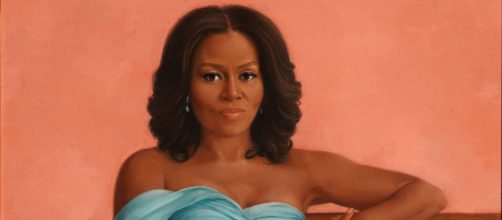Portrait paintings typically interpret people. But effigies of Michelle Obama – the one unveiled at the White House last week and the one that debuted at the National Portrait Gallery in 2018 – look to be more about embed marketing than Michelle.
How else to explain the naming of those who fashioned Michelle’s getups in these portraits whenever the paintings are mentioned?
At the unveiling at the White House, former President Obama, whose portrait also was unveiled, said of the painting of his wife: “I want to thank Sharon Sprung for capturing everything I love about Michelle – her grace, her intelligence, and the fact that she is fine.”
I don’t doubt Obama’s love for his wife.
But where o where is the grace, intelligence, and fineness in Sprung’s painting of Michelle lolling on a divan arrayed in a billowing, off-the-shoulder, loudly colored dress? If the artist captured anything, it’s her flesh, not her fineness or her smarts.
Then there’s Sprung’s interview with Stewart McLaurin, president of the White House Historical Association, aired on YouTube. She sought to capture Michelle’s “dignity and reserve,” she said.
Given the dress's decolletage and flashiness, attributes like dignity and reserve hardly apply. The first Lady's face is the last thing you notice in Sprung’s painting.
Headlining high fashion
Sprung’s portrait, then, appears less about Michelle and more about a product design by Jason Wu, who promotes himself on his website as Michelle’s exceptional occasion dressmaker.
If you can get past all the bared flesh and the high hue of the dress, look at the face Sprung painted. The smiling, upbeat Michelle that the country has come to know is not there.
Instead, you see an unsmiling, rather sad-eyed woman who looks like she’d rather be anywhere than in this painting. It’s as if Michelle were an exhausted fashion model taking a break from a runway show and all the product promotion that goes with it.
Yet, the New York Times has Sprung saying, “I have great respect for traditional painting and having somebody look the way they look. That’s what’s in it for me — the crinkle of an eye, the little noise of a lip.”
Sharing the cost
There’s no crinkle, and the noise is in the dress's color.
But there is an allusion to traditional painting. I’m thinking of the 17th-century Dutch who portrayed successful business people and their wives displaying their success with many renderings of lace, satin, and brocade in their clothes.
In “Portrait of a Woman with a Rose,” the artist Isaack Luttichuys shows a woman actually holding up an edge of her satin shawl as if to call attention to its grandness. See? The lace is the subject of the portrait, not the Lady.
Focus on embroidery on the bodice of a bejeweled figure in “Portrait of Maria Bultel” by Jan Anthonisz. Jan van Ravesteyn also is about the wardrobe rather than the woman.
A portraitist’s attention to what Michelle is wearing can also be seen in Amy Sherald rendition by posing her as if she were modeling the latest fashion.
As it turned out, she was.
The dress in Sherald’s painting – as eye-catching as the Jason Wu dress in the White House portrait – is promoted as the brand MILLY.
But this time, you get a raucous geometric design so flashy that Michelle’s image becomes secondary. What you get instead is another portrait of a dress. And again, the thought of product promotion raises its merchandising head.
Granted. Michelle is a good-looking woman who could have been a fashion model, but she wasn’t. She a graduate of Princeton University and Harvard Law School.
I don’t expect a portrait of this accomplished First Lady to depict her reading or writing a book necessarily. But neither do I expect distracting decolletage and overdesigned duds.
Perhaps a simply close-up would serve. Or is the product the thing?


